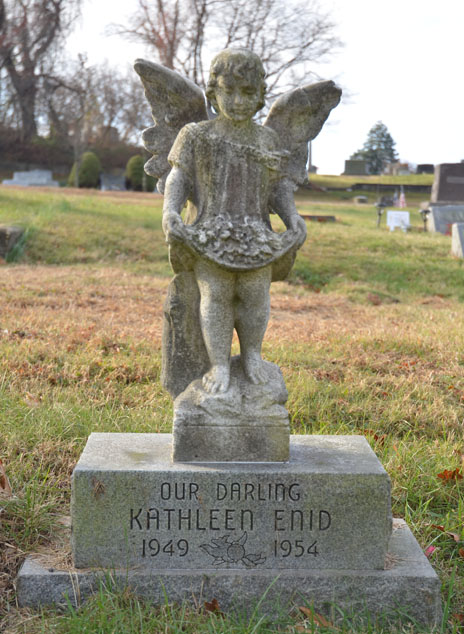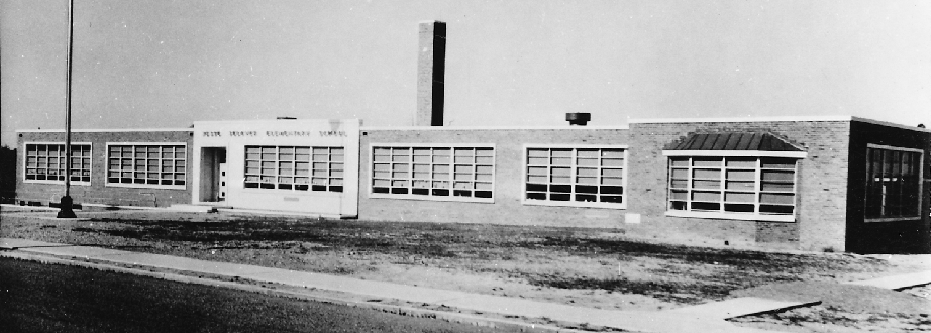
Concerns in the US in the early 21st century regarding the health and safety of elementary school children seem mostly to be about the possibility of someone entering a school with an automatic weapon rather than potentially lethal childhood diseases. Vaccinations, which some portion of parents seem to not believe in, have wiped out a great number of diseases since World War II. So much progress has been made in this area that the terror and fear parents used to live with about the possibility of losing their child to one of these major diseases has essentially been forgotten.
Just a few weeks after Jesse Selover School, the only school in Morgan, opened in September 1954, a tragedy occurred to a five-year-old girl who was a student in the afternoon kindergarten class.
In the 1960s in Morgan, I recall a great number of public service announcements on TV about Rubella (aka, German Measles) and how it was critical that a pregnant woman not be exposed to it. Mrs. Jessen across the street was pregnant during this time and I was concerned for her (child turned out fine) but I don’t ever recall hearing anything about polio. President Roosevelt came down with polio in the summer of 1921 at the age of 39 and lost his ability to walk without very painful aids. This condition didn’t stop him from being the only US president elected to four terms but in those days, his condition was hidden from the pubic even while it was in full view. Until the early 1950’s, there were absolutely no treatments for or protections against anyone, especially a child, acquiring polio in any of its forms.
I once worked with a man who was born in the late 1940s who had to walk using two canes. Eventually he indicated that he had had polio while as a child. Up to about the mid-1950s, many children around the world acquired another form of polio which would impact their ability to breathe. Images of young children, in what were called iron lung machines, were often presented in the media. An iron lung is a cylindrical container a person lies down in which, via the process of lowering and raising the atmospheric pressure inside the cylinder, would automatically perform breathing for the often-young child who had to be inside it.
Fortunately for all of us, treatments to prevent polio were developed in the early 1950s. According to the Center for Disease Control, before these miraculous vaccines were developed, there were about 15,000 polio outbreaks each year in the US. Sadly, for a little girl in Morgan who lived on South Pine Avenue and whose first and middle names were Kathleen Enid, she was one of them.
According to the New Brunswick Daily Home News newspaper, Kathleen had gone to her afternoon kindergarten class at Jesse Selover School on Monday, 11 October 1954. The next day, Columbus Day, was a school holiday and was the day Kathleen became ill. She was taken to Perth Amboy Hospital (now Raritan Bay Medical Center) for examination. Because of the polio diagnosis, the Sayreville Emergency Squad transported her to Monmouth Memorial Hospital, Long Branch, NJ (now Monmouth Medical Center) where she was placed in a respirator. Moving hospitals at that time was necessary according to the spokesperson for the county chapter of the Foundation for Infantile Paralysis as county hospitals no longer had the facilities to accommodate polio patients.
Sometime during the evening of Wednesday, 13 October – one day after becoming ill, Kathleen died of Bulbar Polio.
The Bulbar Polio form of the poliovirus invades and destroys nerves within the bulbar region of the brain stem which is the area controlling the body’s involuntary functions such as, most importantly, breathing and heart beating.
The School Reacts

On Friday, 15 October, private funeral services were held at nearby Mason Funeral Home on Bordentown Avenue in South Amboy. Kathleen was then interned at Christ Church Cemetery in Morgan, a quarter of a mile away from her house on South Pine Avenue.
On that Wednesday, Selover School principal Mr. Vincent Abbatiello learned of Kathleen’s illness, which was confirmed by the school physician Dr. R. H. Barnhardt. In response to this medical emergency, Sayreville’s Superintendent of Schools, Dr. Richard S. Pollack, was rushed to New York City at 3:30 that afternoon by Sayreville Police Department patrolman Chester O’Such to obtain a sufficient supply of gamma globulin serum for inoculations. At this time, gamma globulin serum was the only preventative measure available against polio as the more well-known polio virus vaccine developed by Dr. Jonas Salk would not be announced to the world until six months to the day after Kathleen became ill.
The afternoon kindergarten class was kept at school until arrangements could be made to acquire the serum. They were given notices to give to their parents announcing that the serum would be ready by that evening. They were told, in those days before TV and the internet was everywhere, that the Sayreville Emergency Squad would drive their disaster truck around Morgan announcing the arrival of the serum via the truck’s loudspeaker. These were also the days before cell phones. While driving back to Morgan with the serum, Patrolman O’Such radioed to the Emergency Squad who were standing ready at the school, that they were near the borough. They arrived by 6:10 pm. Within an hour of their arrival, 42 people composed of children, parents, and school adults received the innoculations.
There are some stories still in circulation in the Morgan area, which cannot be confirmed unless someone who was there confirms them, that the school also tore down and burned walls and disposed of any soft materials such as books, paper and the mats used for naps.
It was not indicated, and perhaps was never known, how Kathleen had contracted the polio virus. According to the CDC web site:
Poliovirus only infects humans. It is very contagious and spreads through person-to-person contact. The virus lives in an infected person’s throat and intestines. It enters the body through the mouth and spreads through contact with the feces (poop) of an infected person and, though less common, through droplets from a sneeze or cough. You can get infected with poliovirus if you have feces on your hands and you touch your mouth. Also, you can get infected if you put in your mouth objects like toys that are contaminated with feces (poop).
An infected person may spread the virus to others immediately before and about 1 to 2 weeks after symptoms appear. The virus can live in an infected person’s feces for many weeks. It can contaminate food and water in unsanitary conditions.
People who don’t have symptoms can still pass the virus to others and make them sick.
Kathleen was the first person in Sayreville to contract polio that season and the second person in Middlesex County to die from polio that year. She got sick 65 years prior to the day this was posted. I’m sure the family never got over their grieving.
Thanks to Dorothy Scuorzo and Joyce Elyea for providing newspaper clippings of this tragedy. Dorothy’s mother, Hazel, was the first president of the Selover School Parent Teacher Organization and had copies of some articles about Kathleen. She also had a lot of other information about the early days and opening of Selover School which will be posted on this web site. Joyce is, of course, the indefatigable researcher for all things Morgan and South Amboy and a major contributor to this web site.
Originally posted on October 12, 2019.
I was one of those children who back in the early 1950’s. I remember standing in line with my parents around the Jesse Selover playground to receive a sugar cube with the medication on it. We all were given small vaccination record cards to date when each person was dosed. I was very young but I remember we were given at least a total of three doses spaced out over a certain number of days (or weeks). I knew of young girl, who survived polio, in my Sunday school class from Matawan NJ. She walked with metal leg braces and crutches. I lived on Gordon Ave on west side of 35 Hwy near Connie’s Bar off Lorraine Ave/Ernston Rd.
I grew up with Allan Trubilla who was later in life murdered by his son and partner in Ft Lauderdale Fl. Allan lived very close to my house and were frequent playmates. His murder made national news as his son was initially given a life sentence, even though his was under 18 yrs old, but then later released .
Thank you, Christine! Cynthia Trubilla was in my Jesse Selover class. Such a unique name, I assume they were related.
Try to remember Allan, my brother, with happy thoughts. I’m not feeling it appropriate or respectful for you to write in this very nice informative article, (by Verne, I believe), comments about his murder ! WTH… In these horrific days of a Pandemic, COVID19, I would think murder should be the least on your mind and concentrate on the living.
I am totally shocked that you were kind enough to respond to my post. Thank you. You are right about this sister. I’m sure she is the same person we remember. Allan and I graduated Sayreville War Memorial H.S. In June 1970. I suspect you and I may have crossed paths over our school years. I always get tickled when I tell people that my H.S. name is (long when you have to fill in any official form) and our
“ mascot” was an actual BOMB that was cemented under the football goal post. When asked where Sayreville is (from others from NJ) all I say is “ have you ever heard of BON JOVI . Well he lived about 3 blocks from my H.S. GO BOMBERS!!!!!
Yes, a unique name. Allan was my brother. Christine, were you friends with Cathy, who lived about 3 houses up from us ? I remember the 2 of you girls over our house hanging out. You both were so infatuated with my brother. lol. Even back then women were blind , or maybe just did not care. Thought you could change a person. It’s sad that the only thing that left a life long impression of my brother on you was his murder, and you had to text about it in this article that has nothing to do with it. Not thinking who would read it.. please try to remember my brother in happy times.. I do. To the administrator. I do believe I know and remember you, Verne. Remember, “What doesn’t kill you, makes your harder “.
Hi Cynthia! Thank you for your message.